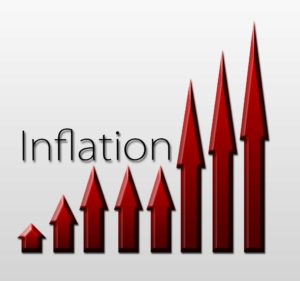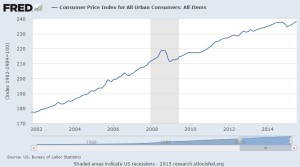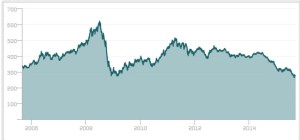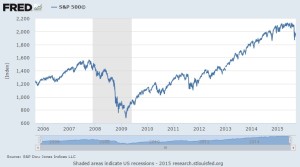What is Inflation?
“Inflation is a continuing rise in the general price level usually attributed to an increase in the volume of money and credit relative to available goods and services.”
This is the definition of inflation according to Webster’s dictionary. While we feel this is a reasonable definition to describe inflation (as most people think of it), the term is also too broad and frequently causes confusion.
The term inflation as it is used by most people is very general. The term would be more accurate if it was used to describe what is experiencing inflation, such as: monetary inflation, price inflation, wage inflation or asset inflation. These terms describe what is happening with more accuracy. By just using the word “inflation”, most people combine multiple types of inflation into one description. However this is not always accurate as you will see below.
Consumer Price Index (CPI) from 2000-2015
The CPI measures the prices of goods and services in the US. This is a generally accepted measure of the rate of inflation in the US. However is it accurate?
As you can see, the CPI has risen steadily from 2000-2015 with a small blip in 2008-2009. Now compare this to wages.
Median Household Income
On the left is the 2000-2015 chart of median household wages. On the right chart is the real median household wages. What this means is that while the wages might be climbing, compared to the CPI, they are actually not climbing as much as the CPI. This means that wages, relative to the price of goods and services, are falling. Consumers can buy less goods and services that before.
Asset Prices
This above chart is of commodity prices from 2005-2015. Compare this with the S&P 500.
While both of these charts are an indicator of asset prices, they are not the same. While the S&P 500 has risen significantly from 2009, the commodity prices have dropped since then.
Monetary Inflation
Now we compare monetary inflation to the rest of the charts. The monetary base is the money the Fed has created, the money stock is the amount of money created by the Fed, banking system and its customers. In essence, if the Fed creates more money via the monetary base, but it is not money unless banks lend it out. It just sits at the fed. Thus it does not create inflation. This is a common mistake that people make when referencing the printing of money.
All four types of inflation are showing different results. This is why it is dangerous to refer to “inflation” in general terms. There is no unifying number that can accurately describe the state of “inflation”.
Is “Inflation” the cause or the effect?
Another confusion about inflation is it is referred to as a cause or an effect, but rarely are the two tied together.
- Cause– The action that caused the change in price.
- Effect– The change in the price of an item – what is typically referred to as inflation or deflation.
It is important to understand both components because frequently you will read about how excessive money printing leads to high-inflation. On the surface, this seems logical. However, in 2008 the Federal Reserve announced a program called Quantitative Easing (QE). There have been multiple versions of this from 2008 to 2014. One of the intentions of these programs was to boost price levels and prevent deflation in the US. Some people refer to this program as printing money or monetary inflation. However this “money printing” has not had the desired effect. Commodity prices, wages, and the price of goods and services have not necessarily risen due to this monetary inflation. If this cause and effect relationship was clear, then the US should have high inflation.
But, we don’t.
Actually the “deflation” that scares economists and the Fed alike is still an issue. Despite multiple quantitative easing programs, the US is not experiencing the growth that is desired.
Each month we publish the Inflation Monitor. This publication tracks inflation and deflation based on publicly available data as well as some internal measures. Each issue contains all of this data, a summary of the data and some relevant charts to review. We also review certain issues that are more topical and relevant at the time. For more inflation about the Inflation Monitor, you can sign up here to receive it each month directly to your inbox.
How Does Inflation Work?
Inflation on a basic level is very simple to understand, however we live in a complex world. Inflation does not work the same way as you might expect. For example, a rise in the price of a chocolate candy bar means that the candy bar is experiencing price inflation. The cause of the change in price of the candy bar is not always known. if could be from a higher cost of buying the chocolate, or higher wages of the chocolate company workers, or higher transportation costs of shipping the chocolate bars, etc. Inflation is not always directly caused by printing money.
One of the more common descriptions of inflation is the expansion of the money supply, or commonly referred to as printing money. For example, from 2000-2014, the money supply in the U.S. grew approximately 147%, from 4.6T in 2000 to 11.4T. Yet price inflation has not expanded at the same rate. The CPI has shown approximately a 40% increase. Clearly, printing money does not directly correlate to inflation.
How is Inflation Measured? What is the Consumer Price Index (CPI)?
The Consumer Price Index (CPI) is traditionally used as a proxy to determine the amount of inflation effecting the US economy. It is a measure of the average change over time in the prices paid by urban consumers (about 87% of the US population) for a market basket of consumer goods and services. This basket of goods and services includes:
- Food and Beverages
- Housing
- Clothing
- Transportation
- Medical Care
- Recreation
- Education and Communication
- Other Goods and Services
Controversy with the Consumer Price Index (CPI)
The Consumer Price Index is generally accepted as the best way to measure price changes in goods and services. However some people find fault with the CPI. One of the arguments against the accuracy of the CPI is that it has had multiple revisions to how it is calculated since prior to 1980. Each revision has ultimately lowered the number. John Williams is one economist who holds this claim.
Other economists also claim that the Consumer Price Index is inaccurate and that other methods should be explored to improve on the current measurement. Innovative Advisory Group holds that position as well. One number cannot possibly epitomize the entire US economy with accuracy. Rather than try to build a better mousetrap and come up with a better way to calculate what is now the Consumer Price Index, we have chosen to create the Inflation Monitor to provide more transparency to what is actually happening in the economy. This report will clearly show you what parts of the economy have inflation, which have deflation, and to what degree each are affected. We have found this approach to be a much more informative and effective method of measurement.
How Does Innovative Advisory Group Measure Inflation?
The term “inflation” is used to reference the general rise in prices. However, it can refer to a number of things beyond consumer goods and services. Here are a few themes that our Inflation Monitor measures:
- Monetary Inflation
- Price Inflation
- Asset inflation
- Commodity Price inflation
- Wage inflation
- Housing inflation
- Food price inflation
- Energy price inflation
- and many others…
In our Inflation Monitor, we attempt to measure different themes to determine how inflation or deflation is effecting the economy. Each theme listed above acts independently of the others. While they might be correlated at times, they move according to their own supply-demand dynamics. To learn more about our Inflation Monitor monthly service, click here.
Deflation
“Deflation is a decrease in the general price level of goods and services.”
It is important to make note of deflation, which is the opposite of inflation (more detail about Deflation here). It could be accurately characterized as a negative inflation rate, or when the rate of inflation goes below 0%. While the existence of deflation should be should be self-evident (as the antithesis of inflation), there is a lot of misconception about what it is and what it means. I plan on writing more about this topic in the monthly Inflation Monitor. For now it is sufficient to understand that it is the opposite of inflation.
What is the Current Rate of Inflation?
In the U.S., inflation is calculated through the Consumer Price Index (CPI). This index is a measure of the change in price for goods and services in the US economy. If the CPI is up 3% from one year to the next, then we can assume inflation for the year is 3%. This is the generally accepted number for inflation. However, it is not always informative to epitomize the entire economy in one number. For example, the average of 4 and 6 is 5. The average of 1 and 9 is 5. The average number is the same, however the individual numbers show a very different picture of what is happening. At Innovative Advisory Group, we feel the same way about the CPI. It cannot accurately contain all the information we need to know about the US economy.
We assess multiple parts of the economy through publicly available information and run it through our proprietary algorithms. Having these assessments about different components of the economy has provided us with a better viewpoint of how inflation is affecting the economy. It is important to note that the different parts of the economy are not always aligned. Some sections of the economy might show signs of inflation, while others might show signs of deflation. Some examples where inflation might show up are: asset prices, commodity prices, wages, housing prices, food prices, energy prices, and monetary.
What Causes Inflation?
Inflation is based on supply and demand. Inflation of the money supply means that there is more supply than demand, so each dollar is worth less. In regards to the value of the US Dollar, when more people want dollars, their value goes up and when fewer people want them, their value goes down. In simpler terms, inflation means that your Dollars are worth less, deflation means your Dollars are worth more.
The most common assumption is that printing money causes inflation. While this can be true, it is not always the case. The Federal Reserve and the U.S. Government have printed up $6.8 Trillion dollars in the 14 years from 2000 to 2014, yet we have seen very little inflation. Inflation is not always predictable, and its cause is not always known.
There are a number of factors that effect inflation and deflation. Some of these factors are:
- money supply,
- technology,
- demographic trends,
- velocity of money,
- unemployment rate,
- debt to income ratios,
- savings rate,
- actual supply and demand of the goods and services,
- and more.
Some of these factors have a greater impact than others. For example, technology and demographic trends have had more of an affect on inflation than the simple act of printing more money.
Technology has caused a massive amount of deflation in the past 20+ years. Advances in technology currently allow goods to be produced and distributed cheaper than before, so their retail prices have dropped in response to this trend. The speed and power of computers has advanced rapidly and predictably over the past 20 years, however the prices of a computer have dropped. This is an example of how powerful the deflationary forces of technology really are.
Demographic trends also have a strong impact on inflation or deflation. Japan is a good example of this. Japan has a strong demographic trend where a large portion of the population is aging. This has put strong deflationary pressure on the Japanese economy. This pressure has persisted for the past 25+ years. Japan has tried many things to reverse this deflationary trend, but so far has not been successful. This topic was discussed at length in one of the Inflation Monitor issues. If you want to learn more about deflation, click here.
Historical Inflation
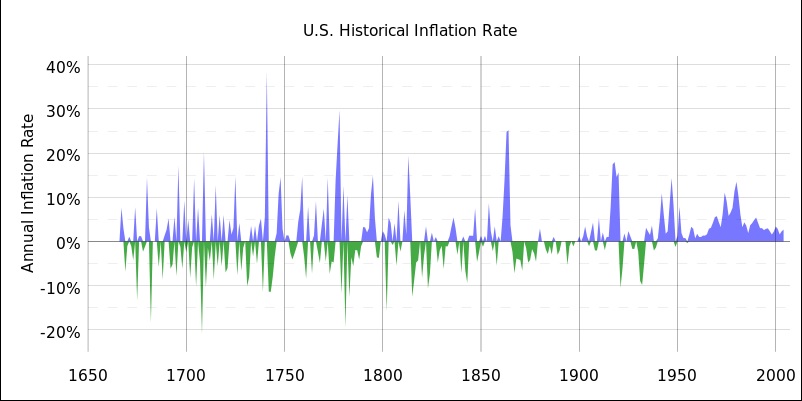
Is the state of constant inflation normal?
It should be clear from the chart above that a constant state of inflation is not normal. It has only been constant for the past 70 years. Throughout US history, both inflation and deflation were considered natural occurrences. It was not until the early 1900s that it was decided, inflation should be muted to a less volatile and consistent positive rate. While the Federal Reserve has tools to moderate the rate of inflation, they do not have the tools to combat deflation.
If you want to learn more about inflation, deflation and how to track it, check out our Inflation Monitor for monthly updates.
You can also join our email list and have the Inflation Monitor sent directly to your inbox.
Related Articles:
- US Historical Inflation Rates
- The Inflation Deflation Balancing Act
- Are Negative Interest Rates in America’s Future?
- Inflation- The Secret to Building Wealth in Real Estate
- Deflation- How a Mortgage Can Destroy Your Real Estate Wealth
- Why Does Deflation Scare the Federal Reserve and Economists Alike?
Sources:

